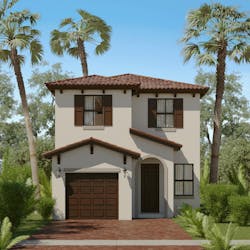Myths and Truths of Millennial Home Buying
After spending the better part of a decade on the sidelines, Millennials are finally starting to buy homes. According to the US Census Bureau, 854,000 new-owner households were created in the first quarter of 2017; more than double the 365,000 new-renter households formed during the same period (Image: 13th Floor Homes).
But while demand among first-time home buyers has kicked into high gear, savvy home builders are realizing that today’s home owners are forcing a rethinking of traditional building strategies. Here are some of the most common myths about millennial home buyers, along advice on how to sell to this growing demographic.
1/ Millennials would rather rent than own. While young professionals may not be dreaming of the traditional white picket fence, the dream of homeownership is still very much alive and well for this generation. The challenge is that very little product – particularly new construction – meets their needs or price point. According to Trulia, 27 percent of online home searches in the fourth quarter of 2016 were for starter homes but only 21 percent of listings were in that price range. Meanwhile, just 44 percent of searches were for luxury listings while 55 percentof home listings were priced at the high end. This pricing mismatch presents builders with a rare opportunity to tap into an underserved market.
Millennials are location-driven. Because many of them have spent the better part of a decade renting, they’re accustomed to a convenient and accessible lifestyle without the hassles that often come with ownership. Developers that can deliver high-quality homes that offer some of the low maintenance perks of renting with included services like lawn and general exterior property maintenance, will find success with this demographic.
2/ Millennials are primarily concerned about the amenities within their homes. While tiny houses and smart homes may be grabbing headlines, experience has taught us that Millennials are just as concerned with the amenities offered outside of their home as those provided within. This has led to homebuyers seeking smaller lots and higher density that makes room for more shared space. Many Millennials don’t care about having a pool on their own property as long as they have to access to one within their community. Our community in Tamarac, Fla., Central Parc, is a prime example. These 253-single family homes may be built on smaller lot sizes, but the neighborhood includes a running trail, picnic area, community park and pool. The project sold out within two years, which only underscores the pent-up demand that exists for this type of product.
3/ Millennials and Baby Boomers want different things. When it comes to housing preferences, these two groups are more similar than one might think. Our firm recently began developing an active adult community in Delray Beach, Florida called Avalon Trails and were surprised to find how much the gap between Millennial and Boomer preferences are closing. Gated communities where golf courses and clubhouses serve as the primary social element are quickly fading among the 55+ demographic. Much like Millennials, Baby Boomers are seeking close-knit communities with shared amenities such as walking trails, gaming areas, pools and fire pits where they can socialize with neighbors in a more casual setting.

